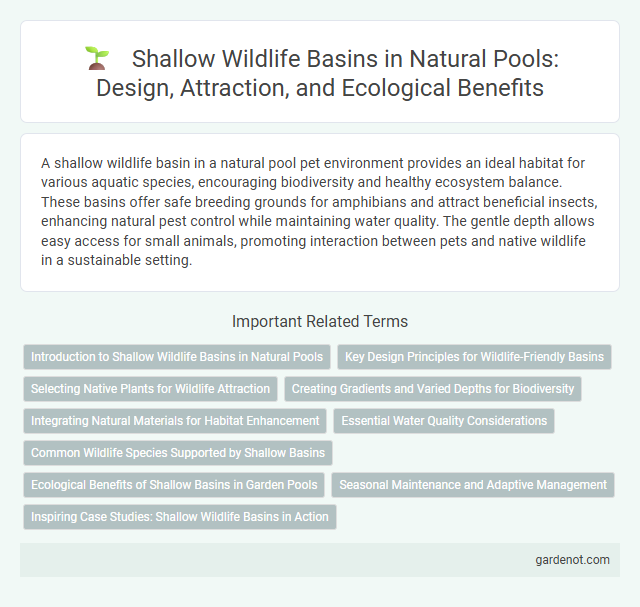A shallow wildlife basin in a natural pool pet environment provides an ideal habitat for various aquatic species, encouraging biodiversity and healthy ecosystem balance. These basins offer safe breeding grounds for amphibians and attract beneficial insects, enhancing natural pest control while maintaining water quality. The gentle depth allows easy access for small animals, promoting interaction between pets and native wildlife in a sustainable setting.
Introduction to Shallow Wildlife Basins in Natural Pools
Shallow wildlife basins in natural pools create essential habitats that support diverse aquatic plants and animals by mimicking natural wetland conditions. These basins enhance biodiversity by providing breeding grounds for amphibians, insects, and waterfowl, while promoting water filtration through vegetation and sediment settling. Optimal design includes gentle slopes and varied depths to sustain different species and maintain ecological balance within the natural pool system.
Key Design Principles for Wildlife-Friendly Basins
Shallow wildlife basins in natural pools prioritize gentle slopes and varied depths to support diverse aquatic and terrestrial species, enhancing habitat complexity and water quality. Incorporating native vegetation along the edges stabilizes the substrate, provides shelter, and promotes biodiversity by attracting insects, amphibians, and birds. Maintaining natural water circulation and minimizing chemical use further supports a balanced ecosystem critical for sustainable wildlife habitats.
Selecting Native Plants for Wildlife Attraction
Choosing native plants such as cattails, sedges, and water lilies enhances a shallow wildlife basin's ecological balance by providing essential habitats and food sources for local fauna. Native species support pollinators and aquatic insects while improving water quality through natural filtration. Selecting region-specific vegetation reduces maintenance and promotes biodiversity within the natural pool ecosystem.
Creating Gradients and Varied Depths for Biodiversity
Creating gradients and varied depths in a shallow wildlife basin enhances habitat diversity by supporting multiple aquatic species. Gradual slopes combined with deeper pockets offer optimal conditions for amphibians, aquatic plants, and invertebrates, promoting a balanced ecosystem. These structural variations improve oxygenation and nutrient distribution, fostering rich biodiversity within natural pools.
Integrating Natural Materials for Habitat Enhancement
Shallow wildlife basins in natural pools use natural materials such as rocks, sand, and native plants to create diverse microhabitats that support amphibians, insects, and aquatic birds. Incorporating organic substrates and gentle slopes replicates natural shoreline conditions, enhancing biodiversity and water quality through biofiltration. These basins serve as critical refuge areas, promoting ecosystem resilience and sustaining local wildlife populations.
Essential Water Quality Considerations
A shallow wildlife basin in a natural pool requires careful management of water quality to support diverse aquatic and terrestrial species. Key factors include maintaining optimal oxygen levels, controlling nutrient concentrations to prevent algal blooms, and ensuring natural filtration through aquatic plants and substrate. Regular monitoring of pH, temperature, and contaminant levels helps preserve the ecological balance essential for wildlife habitation.
Common Wildlife Species Supported by Shallow Basins
Shallow wildlife basins in natural pools provide essential habitats for amphibians like frogs and newts, as well as aquatic insects such as dragonflies and water beetles. These basins support diverse plant species like water lilies and submerged grasses, promoting oxygenation and nutrient cycling. The combination of shallow water and native vegetation creates ideal breeding grounds and shelter for birds, fish, and invertebrates, enhancing overall ecosystem biodiversity.
Ecological Benefits of Shallow Basins in Garden Pools
Shallow wildlife basins in garden pools create vital habitats for diverse species such as amphibians, insects, and aquatic plants, enhancing local biodiversity. These basins improve water quality by promoting natural filtration and nutrient cycling through submerged vegetation and microbial activity. Their design supports ecological balance, reduces algae growth, and fosters sustainable ecosystems within residential landscapes.
Seasonal Maintenance and Adaptive Management
Seasonal maintenance of shallow wildlife basins in natural pools involves regular removal of debris and monitoring water quality to support diverse aquatic ecosystems. Adaptive management practices include adjusting water levels and vegetation control based on seasonal wildlife activity and climate variations. These strategies enhance habitat resilience, promote biodiversity, and ensure long-term ecological balance in the natural pool environment.
Inspiring Case Studies: Shallow Wildlife Basins in Action
Shallow wildlife basins provide essential habitats for diverse species by integrating natural filtration with ecological design, demonstrated effectively in inspiring case studies such as the Eden Project in the UK and the High Line in New York City. These basins use gentle slopes and native vegetation to support amphibians, insects, and aquatic plants while improving water quality through biological processes. Their success highlights the importance of sustainable water management practices that enhance urban biodiversity and ecosystem resilience.
Shallow wildlife basin Infographic

 gardenot.com
gardenot.com